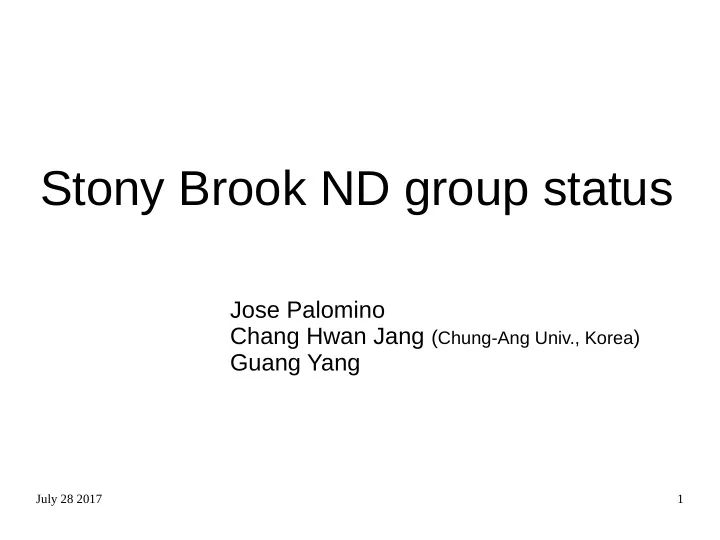

Stony Brook ND group status Jose Palomino Chang Hwan Jang ( Chung-Ang Univ., Korea ) Guang Yang July 28 2017 1
Software July 28 2017 2
DUNENDGGD - Two new shapes have been added to the library. July 28 2017 3
DUNENDGGD Done currently: - included MainDetector class in “Detector module”, same function as Primary and Secondary classes. - General volume could be defined using GenSolid class under Active module. - DLOE class has been moved to SubDetector module - Generated a geometry with ArgonCube (3x3x4m active volume) + 20 cm Aluminum box + Gar box To dos: - Inlcude more realistic Detector Enclosure - Improve ArgonCube. July 28 2017 4
Analysis July 28 2017 5
B-field in the tracker region B-field in the tracker region - Simple large HPG Ar TPC and STT volumes - HPG: 10 times larger pressure than normal gas, i.e. 0.035 g/cc - STT: Gas tube with Ar(75%) + CH4(15%) + CO2(10%) and Kapton tube. HPGAr TPC tank Top view of Straw tube July 28 2017 6
B-field in the tracker region - At the center left, shooting toward downstream. particle gun Example of HPGAr 1T B-filed Muon - Bending curve sagitta vs. travel length of different particles can be calculated. - We can set B-field requirement for different charge separation efficiency. - Compare performance of HPGTPC and STT. July 28 2017 7
B-field in the tracker region HPG STT 1 GeV muon 1GeV muon - First sense is that HPG and STT have similar charge separation ability. - STT bending more significant but multiple scattering is also stronger, they have trade-off effect. - We will quantify the charge separation efficiency with different B-field as function of travel length. It helps to determine the B-field as well as the size of STT/HPG detectors. July 28 2017 8
B-field in the tracker region B-field in the tracker region B-field in the tracker region HPG STT 2 GeV muon 2 GeV muon - Similar conclusion as before for muon. - Will do 1,2,3,4,5 GeV cases. - Will do muon and electron at least. After this, may consider to continue B-field in liquid argon with lower priority. July 28 2017 9
Neutrino-electron scattering in liquid Argon Due to larger mass, Xsec, POT and much lower threshold, ND LAr may have very good statistics. Therefore, we are systematics limited, so we can put very strict cut on E*theta^2. - Only multiple scattering gives ~6% RMS. - Discuss with people about this small value. I require very strict E*theta^2 (even <0.1, we still have good statistics.) as we may have enough statistics. - If I assign E*theta^2 < 1, which means E*theta^2 can go to ~ 2*m_e , the RMS goes to ~20% or larger. - Chris Marshall proposed some new definitions of Electron angle as now I just use the first gamma emission point. Will update this definition. Not yet known how big this July 28 2017 10 would impact the result.
ROCK MUON FHC mu- momentum vs. cos(theta) RHC mu+ momentum vs. cos(theta) cos(nu - muon) cos(nu - muon) muon momentum muon momentum - Neutrino flux RMS at FD is 45km, which means the RMS at ND is ~ 20 m! 100 m A volume cut of 3 x 3 x 4 m were made to check the number of muon events passing “LAr” through. DUNE beam flux Hall (Air) : 16 x 16 x 42 m from Mark’s 50% enlarged design World (Rock) : 32 x 32 x 62 m - Although very energetic muons going forward, the spread is still significant. July 28 2017 11 - A 3D simulation with large number of events will be done to check the impact of air gap.
Recommend
More recommend